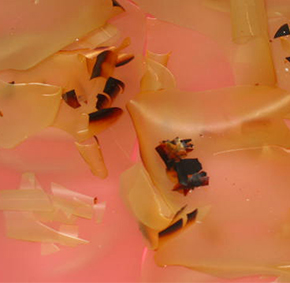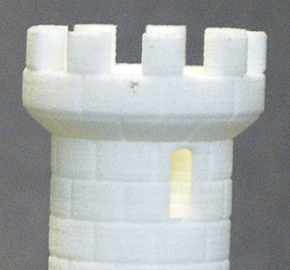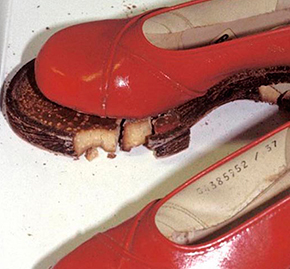Conservation Journal
Autumn 2013 Issue 61
Developing a Strategy for Dealing with Plastics in the Collections of the V&A
Brenda Keneghan
Senior Polymer Scientist

Figure 1. Example of severely degraded cellulose acetate from a display case, Photography by Brenda Keneghan © Victoria and Albert Museum, London
The Victoria and Albert Museum (V&A), as the United Kingdom's national museum of art and design, contains within its collections many objects made from plastic. Because of the nature of their objects, the V&A Museum of Childhood in London's Bethnal Green and the Theatre Collections at South Kensington are substantial repositories of plastic. The Furniture and Textile collections also have a significant plastic content. The early recognition by the V&A of the sheer quantity of plastic objects in the collections and the potential increase in their number have led to it becoming one of the first museums in the world to recognise the problem of plastic degradation (Figure 1). The Museum responded to the issue of degrading plastics in the early 1990s by creating a position in the Conservation Department with particular responsibility for plastics. Since then, research into plastics has continued to be high on the Department's agenda. Most recently the V&A was one of the more experienced partners in the EU-funded project Popart dealing with the preservation of plastic objects in museums and galleries. Today the Museum continues to be a leader in the field and to this end is preparing a proactive strategy for dealing with plastics rather than maintaining a totally responsive position.
In order to establish a practical policy for dealing with plastics there are many questions that we must address. These include: What kind of materials do we currently have and how do we deal with them? What are we likely to collect? What is the collection policy for the future? What technological developments are occurring in plastics and what are designers likely to be using in the future?
Thanks to previous surveys the Museum is in quite a good position with regard to knowing what objects are on the shelves and their condition (Figure 2). It is also privileged in having a Science Section with the analytical capability of identifying the materials involved. In addition, the V&A is up to date with current treatment approaches thanks to recent participation in the Popart. For the existing collection of plastic objects (including loans and exhibitions) in the V&A the following questions are those that I, as Polymer Scientist, am asked most frequently:
- How do I clean this?
- How do I adhere this?
- How do I display this?
- How long will this last (for potential new acquisitions)
- How do I store this?

Figure 3. Nylon chess pieces made by selective laser sintering, Photography by Brenda Keneghan. © Victoria and Albert Museum, London
Some of these issues can be addressed practically and in-house by using, for example, the cleaning protocols developed in Popart or some results from the display parameters currently under investigation. Others require further research but we have at least some of the answers. To support the Museum in its collecting policy, staff awareness of the potential problems that can accompany some plastics must be increased so that informed decisions can be made regarding the acquisition. Similarly, display parameters need to be established for future displays which balance visibility against long term preservation.
The question of what we are likely to collect in the future depends on both the Museum's structure and collecting policies. The recent restructuring of contemporary activities to encompass contemporary architecture, digital design and product design will most certainly increase the number and type of plastic objects coming into the collections. Both the Collections Management Policy (2009) and the Collections Development Policy (2010) state the V&A's intention of collecting contemporary objects and 'new technological and material developments as they impact on material culture'. This will include time-based media, born-digital media and synthetic plastics, materials which present a significant preservation challenge due to their comparative instability and short lifetimes. 'Our contemporary collecting reflects what is new, what is influential, what is innovative or experimental, and what is representative of contemporary social and artistic trends'. '…our contemporary collecting also covers…… new technological and material developments as they impact on material culture'. (Collections Development Policy, April 2010).
It is likely that these potential new materials and technologies will present challenges, therefore any approach to the issue of their care must include both immediate practical responses and a long-term strategy. Research into the stability of new materials and technologies, such asthe use of biopolymers and the different forms of rapid prototyping (Figure 3), must form part of the strategy into future materials.
We can divide our strategy into the short, medium and long-term and allocate specific tasks to each:
Short term (12 months)
- Include a presentation on plastics in the induction training
- Provide handling notes specifically for plastics
- Provide plastics awareness workshops for conservation sections
- Set up working groups to increase the awareness of degradation in various collections containing plastics and/or time-based media
Medium term (1-2 years)
- Provide plastics awareness workshops for collections
- Work with collections and produce a checklist form for all new accessions containing plastic
- Establish appropriate light levels for plastics display
- Establish appropriate cleaning methods for different plastic types. This work will build on results from Popart. This work may be undertaken as a student / intern project.
Long term (3-5 years)
- Work on a conservation-based acquisition policy for plastics, biopolymers, 3-D printed objects & time-based media
- Undertake research in collaboration with the V&A Research Department and universities
- Liaise more closely with art schools e.g. Royal College of Art where artists & designers are experimenting with materials
We have already begun to address some of these issues but as technology moves with such great speed we must ensure that we keep abreast of developments and be aware of the possible implications for our future heritage.
Autumn 2013 Issue 61
- Editorial
- The V&A’s Historic Stained Glass Windows
- An Investigation into the History of a Damascened Iron Games Table
- Collaboration with the Hirayama Studio, British Museum
- An ‘Exploded’ Replica of a Commode
- Smoke and Mirrors: What's holding Hollywood Costume up?
- Developing a Strategy for Dealing with Plastics in the Collections of the V&A
- Computer Love
- The Plaster Cast Courts Project: an introduction
- Historic Repairs
- Textile Sample Books Move
- Research on Paintings – A New Display
- David Garrick’s Tea Service
